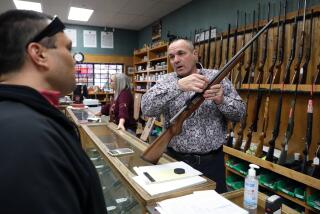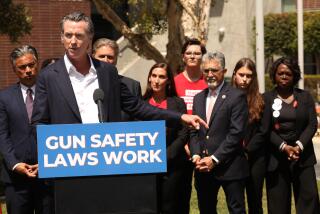Pilots May Not Embrace Law on Guns in Cockpit
WASHINGTON — Commercial airline pilots could start carrying guns into the cockpits as early as this spring as protection against terrorist attacks. But fewer than half are expected to do so.
The homeland security bill that President Bush signed Monday includes a provision allowing pilots on passenger planes to carry weapons if they’re qualified and trained.
Al Aitken, spokesman for the Allied Pilots Assn., said he expects more than 30,000 of the 100,000 U.S. airline pilots will volunteer to become “federal flight deck officers.” Congress stipulated the training should begin within three months.
“It’s not something that we wanted, it’s not something that we’re eager to take on, but as responsible Americans, we realize it’s something that has to be done,” said Aitken, whose union represents 14,500 American Airlines pilots.
Blake Wyttenbach, a pilot for Mesa Airlines, said he’ll probably volunteer to carry a weapon, though he opposed the program at first. “I’d feel a little safer,” he said.
Polls show most Americans want to allow pilots to carry weapons.
Dan McFadden, 78, of Woodbridge, Va., said guns would have given the doomed pilots of Sept. 11 a chance to save themselves.
“They don’t need to know how to shoot a peanut off a stick,” McFadden said this week as he waited to pick up his son at Reagan National Airport. “A body’s pretty big.”
But Jill Roach, 32, of Germantown, Md., said she’d rather see air marshals on all flights.
“Then the pilots could focus on flying,” said the mother of two as she waited at the airport to pick up relatives for Thanksgiving.
No federal air marshal has ever fired a weapon on a plane, said Robert Johnson, of the Transportation Security Administration, created by Congress after the Sept. 11 attacks.
That agency was given broad authority to set standards, develop a training program and write rules for what kind of weapons will be used. The new law also requires airlines to train the flight crew in self-defense.
Johnson said pilots won’t need the 10 1/2 weeks of training that federal air marshals get. Unlike the air marshals, pilots would probably encounter only one or two situations where they’d fire a weapon -- chiefly a cockpit breach -- and would have a much more limited field of fire, he said.
“It will be the right training for the mission they would have to carry out given the environment they’re in and the challenge they would face,” Johnson said. “They’re not going to be air marshals.”
Johnson cautioned, however, that a money shortage may limit the number of pilots who can be trained. Congress didn’t authorize any funding.
Aitken is a member of the Joint Implementation Team, an industrywide committee that has developed a plan to arm pilots. It’s similar, he said, to a report the FBI issued last year on cockpit protection.
The plan calls for volunteers to take a five-day, 48-hour training course in which they’ll fire off 2,000 rounds of ammunition. At the end of the training, pilots will act out a scenario in which a hijacker storms the cockpit.
Aitken doesn’t think it will be too hard.
“I could reach over my shoulder with my firearm and hit the door without even looking,” he said.
Though it’s been suggested that weapons be stored in the cockpit, Aitken said pilots want to carry their guns, preferably semiautomatic pistols, with no limits on ammunition.
After all, he said, “we give guns to USDA meat inspectors, forest rangers and postal inspectors.”
That’s the problem, said David Plavin, president of the airport organization, Airports Council International. For years, airports have been trying to limit the number of people with guns who have access to planes.
“A number of us can tell you stories about an armed federal law enforcement officer falling asleep on a plane, his jacket falls open, the gun falls out, someone picks it up and goes to another law enforcement officer, and they barely avoid a shootout,” he said.
Plavin said airport managers want to know where the guns will be kept when they’re not on planes and how access to them will be controlled.
“Are these guys just going to be marching around with sidearms anywhere ... they want?” he asked.
Some contend pilots won’t need guns because new bulletproof cockpit doors are to be installed by April.
However, the doors must be opened for bathroom breaks, meals, relief crews and as part of airline procedures to check equipment, Aitken said. Pilots would learn how to deal with an attack when they’re outside the cockpit, he said. They’d prefer to be trained at FBI training facilities or at federally approved firing ranges throughout the country, he said.
“We pilots have never wanted to get into this program because we were a bunch of sharpshooting gunslingers,” he said. “We’re very serious-minded.”
More to Read
Sign up for Essential California
The most important California stories and recommendations in your inbox every morning.
You may occasionally receive promotional content from the Los Angeles Times.










